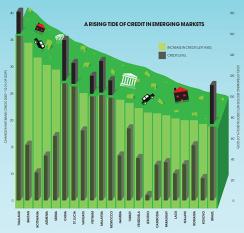More than five years after the outbreak of the 2008–’09 financial crisis, advanced Western economies finally seem to be on the mend, but credit risks are building up fast in emerging markets. Bank lending expanded at robust double-digit rates between 2007 and 2012 across more than two dozen emerging-markets economies, according to the World Bank. The outstanding level of bank credit in some countries now approaches or exceeds levels in the West. In Thailand credit stood at roughly 170 percent of gross domestic product at the end of 2012, having grown by more than 35 percent of GDP from 2007 through 2012. Brazil, China, Morocco and Vietnam also have shown elevated credit growth.
Such figures don’t mean a crisis is imminent, but they do suggest heightened risk, especially if global credit tightens. The World Bank projects that capital flows to developing economies will remain steady this year at about 4 percent of GDP. But if ten-year U.S. Treasury yields were to rise by 100 basis points in the first half, capital flows would drop by half for a period, denting growth, the Bank projects. In such an environment good credit can turn bad quickly.

Get more on emerging markets.





